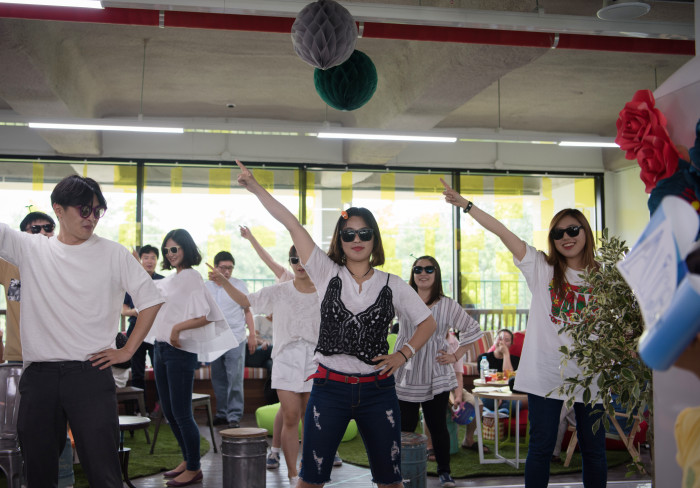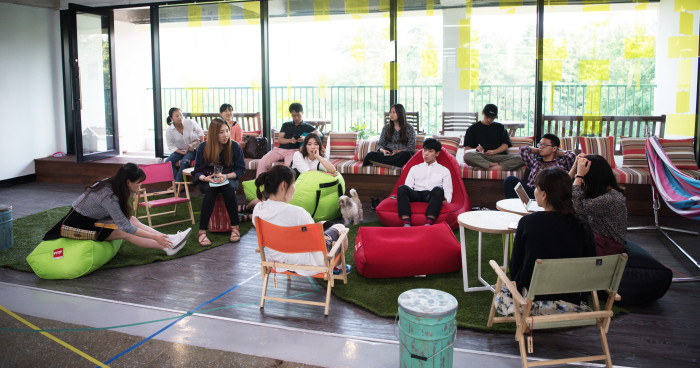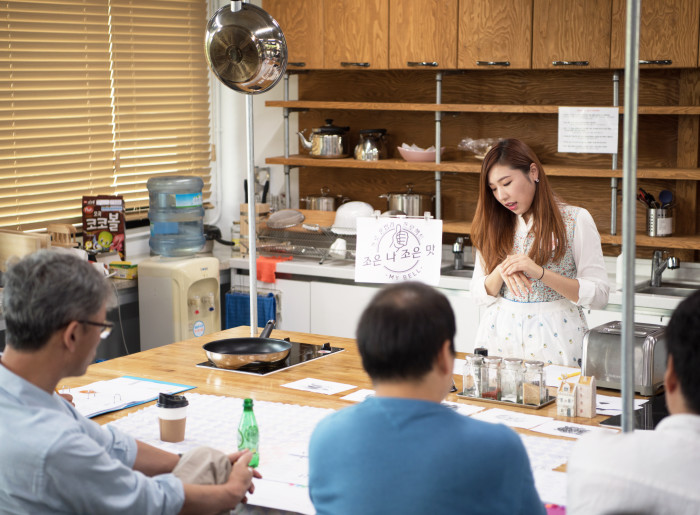경기문화재단
Redesign of Culture & Cultural Policy
Cultural Policy is a quarterly magazine published by the Gyeonggi Cultural Foundation since the summer of 2017 with the purposes of identifying new trends in cultural policies at home and abroad, gathering the opinions of experts in relevant areas, and introducing the directions and contents of diverse cultural policies promoted by Gyeonggi Provincial Government and Gyeonggi Cultural Foundation. |
Writer | Na DoSam
Ⅰ. Inertia and Habitual Routine
Culture always changes. It is changed by numerous elements such as people’s lifestyles, diverse relationships, connection to different cultures and new experiences. Culture is full of changes. It is impossible to predict such changes. There is just a certain flow of such changes.
Cultural policy is basically designed to invigorate such culture. It thus needs to change as fast as culture and respond to changes. However, is it the case for cultural policy in reality? Looking back, cultural policy has never be that fast. Rather than taking the lead in changes in the context of changing reality and rather than leading current trends, cultural policy just followed changes. Worse than that, cultural policy often didn’t follow changes but it maintained itself, under the principle of ‘inertia’ and ‘habitual routine.’ For example, policy supporting the arts has been implemented with inertia, regardless of current trends. Too often, it is even said that the policy is complete. The world is changing but policy fails to be free from its existing old framework.
Actually, this is one of the most common phenomena observed at numerous cultural institutions. It is true that changes have been made but many cultural organizations are still carrying out projects supporting the arts as their major projects. I don’t mean that they are completely wrong but “cultural foundations” need to conduct “cultural projects,” not “artistic projects.” In other words, they need to come up with projects that could invigorate local culture. However, they are concentrating on projects supporting the arts, thinking that it is all that they can do. Such an attitude is not appropriate. That is because cultural policy and arts policy are completely different and the arts and culture are completely different fields.

Ⅱ. Border between the Arts and Culture: Esthetics of the Difference
Are the arts and culture different? Many people may say no to this question obviously. Compared to other countries, Korea often connects the concept of culture to that of art or it even substitutes one for the other. Thus, it may even be a taboo for Koreans to separate the arts from culture and vice versa. To Koreans, culture is art and art is culture.
Nevertheless, are the arts and culture the same? The answer is no. The two concepts are totally different. While culture is the identity of a given group, region or society, arts refer to esthetic works expressed with humans’ creative activities or the activities themselves. That is why the two concepts are never to be mixed. However, in reality, people connect these two concepts or replace one with the other, thus generating confusion in policy. Examples of such confusion are the terms we use habitually: “arts and culture,” “cultural enjoyment” and “cultural exclusion.”
The expression “arts and culture” directly substitutes the arts for culture. Here, “culture” modifies “arts” so it doesn’t mean identity any more but it refers to culture. Consequently, “culture” becomes “arts.” Korea’s representative institutions supporting the arts include Arts Council Korea and Korea Arts & Culture Education Service. Why would they use the expression “arts and culture”? What is their concept of “culture”? Would they have their own concept of “culture”?
Such a changed concept is then transformed into diverse policy terms: “cultural enjoyment” and “cultural exclusion.” “Cultural enjoyment” means to “feel or enjoy culture.” However, in Korea, cultural enjoyment actually means “visiting art spaces.” The Korean government conducts the Survey on Citizens’ Cultural Enjoyment every three years and the survey is focused on visiting art spaces or engaging in artistic activities. Here, cultural enjoyment doesn’t mean to enjoy unique culture which is the identity of a given group, region or society but it means to visit art spaces.
The expression “cultural exclusion” is even more extreme. Cultural exclusion means that someone is excluded from culture. Would there be any group that is excluded from culture? As I mentioned before, culture is the identity of a group, region or society. Is there any group, region or society without such identity? No. However, we use the concept of “cultural exclusion” to refer to citizens who cannot visit art spaces or to those who are excluded from the arts economically and geographically. This is thus a term for welfare projects. Without recognizing the identity of each group, region and society, we just concentrate on providing local areas and society with the universal content of the arts.
However, as I stated before, the arts and culture are different. While culture is the uniqueness of a group, region or society, the arts refer to the results of humans’ esthetic and creative activities or the activities themselves. Thus, in order to encourage cultural enjoyment, we need to strengthen the “culture” or “identity” of a group, region or society. In order to overcome cultural exclusion, we need to help all groups, regions and society express themselves well. In short, we should conduct “output” projects that reveal the uniqueness of each group, region and society instead of removing such uniqueness through the input of the arts. Cultural projects and arts projects are totally different in this way.
Ⅲ. What is Then the Role of Cultural Policy?
Nevertheless, Korean society still combines cultural policy and arts policy or replaces one with the other. Many of the country’s institutions promote an arts project as if it were a cultural project or they replace one with the other. Is it right? If not, what should be the role of cultural policy?
To understand the role of cultural policy, we need to know the basic logic behind culture. That is because we need to understand the basis of culture to carry out projects strengthening or invigorating such a basis. As the identity of a group, region and society, culture forms itself basically with four elements: history (temporal element), art (esthetic element), systems and relationships (power of daily life) and exchange and convergence with other cultures (element of convergence).

First of all, culture is greatly influenced by time or long-term stagnation. It takes time for a group, region or society to form its own pattern and style. Externally, the group, region or society receives its own symbol. Internally, it exerts its power to define the scope and framework of its people’s action and thinking. Therefore, the most important elements of culture are a long period and the power to form a group’s own identity.
Second, the power of art, which resides in a society’s pattern of creative activities, also contributes to culture. Art represents a given society’s dynamism or cultural power. Art shows new styles in itself to enable social imagination. Art also helps us reflect on the present and prepare for changes. Without art, culture is just a group’s identity in daily life. By meeting art, culture is provided with power.
Third, daily relationships also constitute an important element of defining culture. Cultural dynamism depends on democratic relationships and autonomous individuals. If a group is dominated by one-sided relationships, the group may have a strong culture but it doesn’t have great cultural power. Such a culture looks inactive. A case in point is Korean society’s overall culture. For example, the culture of Korean classrooms looks too inactive.
In contrast, if each individual is autonomous, the group’s cultural power is great. However, if its power is excessive, the group fails to form cultural uniqueness.
Such daily relationships, which are formed in individuals’ group, region or society, are influenced by any place that is part of daily life such as systems and spatial structures. That is because the culture of a given group, region or society depends on the following factors: relationship between laws and systems, relationship with neighbors or with the community and shape of space.Lastly, culture is also formed through exchange with other cultures. By being mixed with other cultures, a culture innovates itself to have a new shape.
Thus, the implementation of cultural policy requires us to consider these four elements: history, art, daily relationships and convergence with other cultures. In particular, Korea has a long history of division and it doesn’t have its own style of art. Moreover, the country’s daily relationships are normative, institutional and authoritative. As for convergence with other cultures, Koreans find it difficult to embrace those who are different: conservative or liberal, different generations, migrant workers and a sexual minority. In that case, cultural policy becomes a big challenge. Where could Korean find the identity of its culture? How could the country form its own artistic style? How could it make its daily relationships cooperative and autonomous? How could it embrace different cultures to ensure their coexistence? All of this constitutes the challenge of cultural policy. Cultural policy is not about supporting art but about changing the basis of our life, history and living.

Ⅳ. Direction and Strategies for Innovation
Many cultural foundations have made efforts to meet this challenge. GyeongGi Cultural
Foundation, one of the leaders of Korean cultural foundations, has been commensurate with
its long history to take the lead in training young planners or in innovating the life of Gyeong-
Gi-do Province’s residents by conducting local innovation projects through the arts. Such efforts
made by the Foundation implies gradual changes in the topography of Korea’s cultural
policy. As the Korean saying goes, I would like to whip an already galloping horse. For Korean
cultural policy institutions that are willing to go beyond arts policy to adopt real cultural policy,
I want to make four suggestions for changes. The suggestions are about changing the goal,
method, active participants and system of cultural policy.
First, I want them to change the goal of cultural policy. The goal of cultural policy must be “citizens’ life.” For GyeongGi-do Province, it is to help the province’s residents live a better life. A cultural foundation needs to serve as a developer of life’s agenda. That is the strategy that a cultural foundation needs to adopt as a cultural institution.
How could it embrace different cultures to ensure their coexistence?
All of this constitutes the challenge of cultural policy.
Cultural policy is not about supporting art
but about changing the basis of our life, history and living.
A cultural foundation needs to serve as an institution in charge of life’s agenda when implementing policy. It means that the foundation should look into the problems that are found in local residents’ life. The problems would include the young unemployed, their family, long commutes, deteriorating areas and the elderly left alone. Observing people’s life carefully, problems are everywhere. How could we solve these daily problems? Cultural foundations need to make use of their different capacities to solve these problems in collaboration with diverse people including artists and cultural planners. Doing this will require us to change the method and active participants of cultural policy.
The method of cultural policy should be changed from one-sided support to cooperation. To be more specific, our question should change from “What could we do for artists” to “What could we do with artists?” Cultural foundations will then be able to implement their policy with projects supporting activities shared with artists or carried out by artists, instead of just involving artists in their projects. In short, the problem should be solved with cooperation instead of support. Naturally, this leads to the third change: that of active participants. GyeongGi Cultural Foundation is not the active participant of cultural policy any more. The Foundation just makes a framework for policy and everyone in the framework is now an active participant of policy. Many people including cultural planners and artists will serve as such active participants and depending on their activities, policies will become very diverse.
Therefore, it is necessary to change the system. Instead of projects conducted at the metropolitan level (i.e. GyeongGi Cultural Foundation), we need cultural planning independently led by basic and small units. Such cultural plans could then be supported. Cultural institutions including GyeongGi Cultural Foundation should help each group, region and society plan cultural activities. They also need to train competent planners and artists who could solve these communities’ problems. In this way, each group, region and society will be able to meet competent planners and artists to solve their problems. This is the true cultural policy. In that sense, cultural institutions should serve as trainers of planners and artists and supporters of cultural innovation in each group, region and society. In other words, cultural foundation’ future role is to serve as supporters of each group, region and society, but not supporters of artists.

Ⅴ. Conclusion
Amid the confusion over cultural policy and arts policy, I started by explaining the concept of culture to suggest the future direction of cultural policy. It is true that such a suggestion for the future direction requires changes that are too radical or fundamental. Thus, it may be difficult to make the changes immediately. Nevertheless, the world is changing and policy demands are also changing rapidly. We need to prove the usefulness of a given policy for budget allocation. We also need to prove its efficiency to be able to implement the policy. Under these circumstances, it is not right to maintain the current principle of inertia. It may be difficult but we need to change the direction of our boat even very gradually, in order to ensure future changes.
To change the direction of our boat, in other words, to change that of cultural policy, we should ceaselessly question the current practices and policies. If we don’t ask questions to see if our current policy is cultural policy or arts policy, we will fall into chaos right away and go back to our former state. That is what habitual routine is about.
In order not to go back to habitual routine or the former state in a meaningless way, we need to keep asking ourselves questions. The questions are simpler than what you may think. We only need to check if we aren’t substituting the arts for culture. We only need to avoid using special terms that we regard as something great. To be more specific, if we avoid using terms like “cultural enjoyment,” “cultural welfare,” “cultural citizen,” “cultural city” and “cultural GyeongGi,” we will be able to understand the fundamental meaning of cultural policy.
I suggest that we describe culture with better terms and that we modify culture with other words in order to have an idea about what cultural policy is. For example, if we say “urban culture” instead of “cultural city”,“citizens’ culture” instead of “cultural citizen” and “GyeongGi’s culture” instead of “cultural GyeongGi”. we will finally be able to see the culture of the group, region and society and find their problems. We need to see culture as the identity of a group, not as esthetic topography or superiority. We will then be able to integrate cultural policy into our life. In this context, I look forward to changes in Korea’s cultural policy in the future.
Cultural Policy Bulletin Vol.2 E-book
<ggc의 모든 콘텐츠는 저작권법의 보호를 받습니다.>
세부정보
Writer/ Na DoSam, Senior Research Fellow, Dept. of Urban Society Resarch at the Seoul Institute